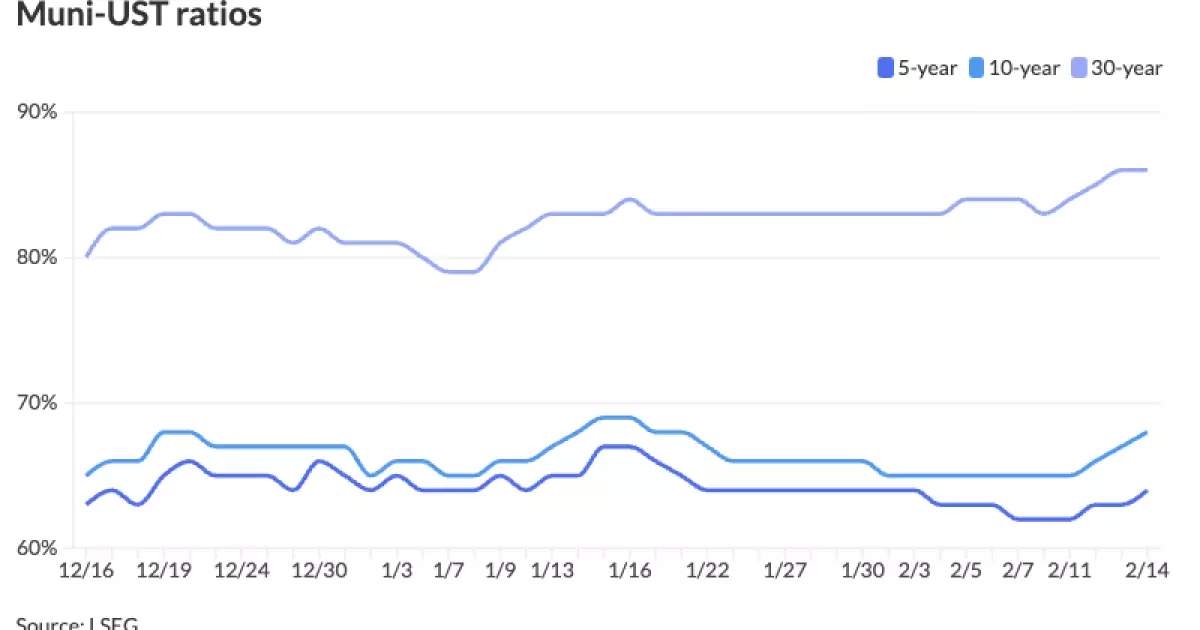The municipal bond market, often seen as a stable investment for both individual and institutional investors, is currently showcasing intriguing trends influenced heavily by macroeconomic factors. With U.S. Treasury yields exhibiting a downward trajectory and equity markets displaying mixed results, the environment for municipal bonds has also been notably positive as we head into February. As investors navigate this landscape, several key themes emerge, illustrating the complexities and ongoing challenges the market faces.
Recent reports from Bank of America (BofA) reveal that the municipal bond market appears to be firming, attributed in part to a smaller new-issue calendar. Notably, the decline in U.S. Treasury yields has provided a conducive backdrop for municipal bonds. However, last week’s solid labor market data halted a Treasury market rally. In juxtaposition, inflation concerns have led to what strategists describe as “bear steepening” within the Treasury curve, illustrating that while short-term yields may be falling, long-term yields are experiencing upward pressure due to inflation fears.
This volatility in Treasury rates poses challenges for municipal bond trading, whereby sharp fluctuations complicate liquidity and pricing strategies. Despite these hurdles, analysts suggest that municipal investors should brace for an environment where Treasury yields remain range-bound for the foreseeable future. Until there’s substantial evidence of declining inflation, these fluctuations could continue to dominate the market sentiment.
When looking ahead, the municipal bond issuance for the coming week is estimated at a modest $5.5 billion, a number that reflects the challenges of a shortened trading week due to holidays. Nevertheless, the overall supply remains robust for the rest of the month, with current visible supply measured at over $10 billion. Given this context, demand appears to outstrip supply, bolstered by large redemption volumes and positive mutual fund inflows.
The relationship between supply and demand is pivotal in understanding the current market dynamics. Analysts at BofA emphasize that while new issuance has picked up slightly, significant inflows from mutual funds are overwhelming the new issuance, indicating a healthy demand environment. This is especially pertinent in times of economic uncertainty, where investors tend to gravitate towards the relative safety of municipal bonds.
Another noteworthy aspect of recent market activity is the fluctuation in municipal-to-U.S. Treasury (UST) yield ratios. The latest figures reflect a slight cheapening in these ratios, with two-year municipal to UST ratios at approximately 63% and 10-year ratios at around 68%. The modest decline in these ratios may signal that investors are still looking for value within the municipal sector amidst rising inflation pressures, highlighting a conservative approach in their investment strategies.
Moreover, the AAA municipal yield curve’s steepening trend underscores a growing defensiveness among investors regarding duration exposure. The changing slope of the curve, shifting from an inverted state to a more normalized trajectory, indicates a burgeoning confidence in the long-term viability of municipal bonds as an asset class. The recent steepening, with the 10s30s slope surpassing 100 basis points, highlights a tactical shift by investors as they hedge against potential inflationary impacts.
As we look at the upcoming new-issue calendar, significant transactions are on the horizon. Miami-Dade County, for instance, is set to lead with a substantial offering of airport revenue bonds, indicating ongoing investment in infrastructure despite broader economic uncertainties. The issuance is expected to attract considerable attention, given its strategic implications for regional development.
In addition to Miami-Dade, other notable offerings include the Pennsylvania Economic Development Financing Authority’s revenue bonds, underscoring continuing investment in both economic development and infrastructure across several states. The competitive calendar’s prominent positions also highlight a diverse range of opportunities. These new issuances offer critical insights into investor sentiment and the market’s direction.
The municipal bond market is charting a nuanced path amidst oscillating economic indicators and mixed market performance. Investors are faced with a delicate balancing act of navigating rising inflation fears while seizing opportunities in new issuances. With favorable supply-demand dynamics and a market characterized by a defensive outlook, the road ahead portends a challenging yet promising landscape for municipal bonds.
The necessity for a careful analysis of emerging trends, coupled with strategic investments in new issuances, remains paramount. As investors parse through the complexities of the current economic climate, a foundational understanding of municipal bonds’ inherent strengths and weaknesses will be essential in capitalizing on their potential benefits amid uncertainty.

